|
FAQs about Yellow Tang Disease/Health
9
FAQs on Yellow Tang Disease: Disease 1, Disease 2, Disease 3, Disease 4, Disease 5, Disease 6, Disease
7, Disease 8,
Yellow Tang Disease 10, Yellow Tang Disease 11,
Yellow Tang
Disease 12, Yellow Tang
Disease 13, Yellow Tang
Disease 14, Yellow Tang
Disease , & Paravortex/Black Spot
Disease,
FAQs on Yellow Tang Disease by Category:
Diagnosis,
Environmental, Nutritional,
Trauma,
Pathogenic (infectious, parasitic),
Social, Genetic,
Treatments
Related Articles: Yellow
Tangs,
Related FAQs: Best Yellow Tang
FAQs, Yellow Tangs 1, Yellow Tangs 2, Yellow Tangs 3, Yellow Tangs 4, & Yellow Tang FAQs:
Identification, Behavior, Tang
Behavior, Compatibility,
Selection, Systems, Feeding, Reproduction, & Purple Tangs, Striped Sailfin Tangs, Zebrasoma Tangs, Zebrasoma Identification, Zebrasoma Behavior, Zebrasoma Compatibility, Zebrasoma Selection, Zebrasoma Systems, Zebrasoma Feeding, Zebrasoma Disease, Zebrasoma Reproduction, Surgeons In General, Tang
ID, Selection,
Compatibility,
Systems, Feeding, Disease, Fish Worms Diseases,
|
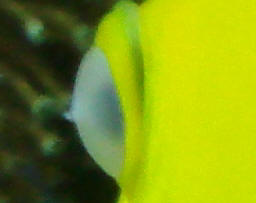
|
Surgeonfishes: Tangs for Marine Aquariums
Diversity, Selection & Care
New eBook on Amazon: Available here
New Print Book on Create Space: Available
here
by Robert (Bob) Fenner |
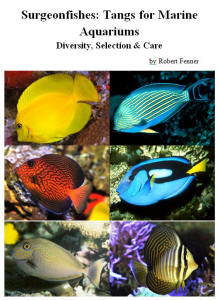 |
Desperation for anorexic yellow tangs Tang health: Probable
copper poisoning 5/31/2009
Hi there
<Hello>
I apologise in advance for the length of this message/question and
would also like to congratulate you on the most informative and helpful
website I have found.
<Thank you for your kind words.>
I am writing from the UK so will convert to litres.
<Liters, gallons, UK gallons, whichever you are most comfortable
with.>
I have 3 marine tanks, 2 display (450l and 400l) and one QT (100l). The
QT is my problem NH4 -0, NO2 - 0, pH 8.0, NO3 currently about 10 SG-
1.020 for past week. (I only use in date Salifert test kits so I am
sure they are reliable measures, expensive but the best IMO) QT is
completely bare except a few plastic pots to hide in, is run by
external Fluval 204, 1 wave p/head and 2 air pumps.
<Sounds fine.>
I have had 2 yellow tangs and a maroon clown in the QT for several
months now due to various problems/diseases. Within 3 weeks of getting
them both tangs developed white spot /Ich and I treated this
successfully with a copper based treatment called Cuprazin (clown
showed no symptoms at all).
<Hmm, not familiar with the product.>
They all fed well until towards the end of the treatment when the tangs
stopped eating, but within 2 days of stripping it out and adding
vitamins they began eating again. All 3 seemed fine and I was at the
end of the
further 4 wk period, almost ready to transfer into display tanks when I
went away for a few days and neighbours clearly massively overfed
whilst I was gone.
<As neighbors tend to do. Read here:
http://www.wetwebmedia.com/feeding.htm
>
NO3 was 15- 20 when I went and a huge 40+ when I returned. Consequently
all 3 fish were struggling /breathing more heavily, both tangs
displayed reddened areas on both sides at the back end and base of
fins, and the clown was covered in grey film patches and some white
spots. I obviously did repeated water changes to get control of NO3
again and added an anti internal bacteria product by interpret, with no
response, so after required time I discontinued use, changed more water
and stripped out ( using Polyfilter). LFS then recommended using a
combined malachite green and formalin product as they wondered if it
was Brooklynella on the clown?
<Hmm... not Brooklynella.>
I couldn't come up with an alternative diagnosis so I did as
suggested for required time, again with no response, so I stripped out
( using carbon) and water changed etc.
<Do read here:
http://www.wetwebmedia.com/ca/volume_6/volume_6_1/brooklynella.htm
>
At this point after searching on your site and everywhere else I
decided to just keep improving/maintaining water quality to see if they
would heal themselves and indeed this seemed to happen, very steadily
the patches became smaller and red colour went paler on tangs and, the
clown began to look more normal.
<Very good.>
Throughout these earlier treatments they all kept eating but the tangs
were slightly less interested than usual in Nori, however, just as they
appeared almost fully recovered one of the tangs started flashing
against the
plastic pots repeatedly (near its gills particularly) and stopped
eating and the breathing became more rapid. Spoke to LFS and they
stated it must be a parasite, not just bacterial due to this behaviour
so I began treating with the copper product I had previously used
successfully.
<Hmmm....>
Both tangs seemed distressed by this and began doing some strange
behaviour - nose pointing upwards/ heavier breathing/ moving around
less and neither of them were eating whilst copper was used ( clown
again eating like a horse) . I became deeply anxious but continued to
treat until the flashing stopped, then stripped out (using Polyfilter)
and did 30% water change.
<You need to stop dosing with copper. Copper is toxic, particularly
to the natural fauna that live in the digestive tract of Tangs.>
Again I left them to improve and again steadily the red colour
continued to fade and the greedier tang started eating again but only
brine shrimp (not Mysis which is their usual staple) and occasional
flake, no Nori whatsoever. The other tang has not eaten since this time
which must be at least 4 weeks now, except for one day (when he ate
some Nori and one flake). I am astounded that he is still alive and am
thoroughly despondent at what to do for him ! He continues to have
heavier breathing and moves around but is almost skeletal. I have tried
everything I can think of : a huge range of formula flakes/ herbi
flake, live brine, Mysis, enriched Spirulina/omega 3 frozen food, krill
etc etc I have added garlic and vitamins to both food and water. Nori
is constantly available and replaced daily. I have racked my brains for
changes as the other tang has now also stopped eating for the past 5
days and is getting rapidly thinner too. The clown continues to eat
like a horse and is eating for 3 now ! !
<As Clowns will do if given the chance. It doesn't look good for
the one Tang, just keep trying to get it to eat.>
In terms of symptoms the clowns have gone except for 1 tiny grey/white
spot above the eye. The tangs bodies are yellow again, although there
is light pink discolouration on the skeletal one at the back end and
one persistent small red patch on the other tang over his brow /
forehead and a few red/brown dots on his body. Both tangs still seem to
be breathing slightly heavier than their usual pattern.
<Stress, healing.>
The only changes I can think of in the past week are: reducing SG
slowly from NSW to 1.020 ( approx 1 week ago) in an attempt to aid
healing and breathing, adding extra vitamins to the water on a daily
basis ( the product suggests this if they are sick or weakened),adding
a skimmer and new carbon.
<Are they still in the QT tank, or are they in the main tank? If
they are still in QT, I would get them back in the main tank as soon as
possible.>
So my first question is could any of the above be making them anorexic
?
<Stress, repeated exposure to toxins that may or may not have been
beneficial>
my second question in desperation and complete confusion is please,
please, please do you have any ideas or advice of what else to try ? ?
I have scanned your site over and over in the hope of finding some
answers or inspiration but so far the only new thoughts I have had are
adding some coral sand from existing display tank that contains tangs
in case they have lost internal gut fauna/bacteria,
<This is likely.>
adding rotifers/ plankton in the hope they mistakenly ingest some and
adding other marine algaes Caulerpa/hair etc (which I did 2 days ago
with no success yet)
<I would put them back in the main display.>
Also what do you think the clown had ? and could the anorexia just be a
further declining stage before death and if so what disease do you
think they have had for future reference of how to treat etc ?
<Likely poor water quality and not necessarily a disease.>
Many thanks for any help you can give, I am absolutely desperate now or
would not have bothered you. Please respond quickly if at all
possible.
Keep up the great work you do
Many thanks in advance.
<MikeV>
|
Identification Problems - Need Guidance... Scuds,
Myrionema and fish health problems. 5/13/09
Hello WWM Crew!
<Hi Christopher! Mich with you today.>
I've searched through the WWM website for a while now and I
just can't seem to find a positive identification for three
different things/issues I am having with my aquarium.
<Let's see if I can be of help.>
For starters, my 90 gallon aquarium has been established for a
year and a half. All water parameters are within normal ranges
with 0 nitrates/nitrites/phosphates, calcium approx 420, pH
8.2-8.5. I have 2 percula clowns, 1 Firefish, 1 scooter blenny, 1
yellow tang, 1 powder brown tang, 6 green Chromis, 1 brittle
star, 1 Sandsifter star,
<Not a fan... decimate your sandbed and slowly starve to
death. Best left in the wild in my humble opinion.>
red hermit crabs,
<Not a fan of crabs either... or hermit crabs... Just not to
be trusted.>
common snails, 1 rose bubble-tip anemone (clown host), frogspawn
corals, button polyps, yellow polyps, an beautiful Alveopora,
various mushrooms, a green brain coral, finger leather coral, disk coral, 2 feather dusters, 2 cleaner shrimp, and a large
decorator crab.
<I'm skeptical with crabs... opportunistic omnivores in my
experience.>
Everything is lit by 150W metal halide lamps and blue actinics. I
have a sump set up below tank with a protein skimmer, filter
pads, and a carbon bag. I do a 10% water change every other
week.
<Good husbandry practices will serve you well.>
The first unidentified problem is with my yellow tang (picture
attached). I can't quite tell what the problem is
<Is difficult to see the damage on the tail section in your
photo.>
- but there seems to be some damage developing along both sides
near the 'nails' by the tail. Almost like erosion.
<I will bounce this to Christine, our resident sick fish
expert.>
The lip of the tang also seems to be wounded and he is constantly
twitching up against the glass on one side of the tank.
<I do see the abrasion on the lip. This could be caused from
the tang rubbing against the glass, or both wounds may be
aggression from tankmates, perhaps the Powder Brown.>
When fed, he eats normally (which is a lot!) and his gills look
okay.
<Good signs.>
I thought maybe HLLE but I really have no idea and this
doesn't quite seem to fit the descriptions.
<Doesn't look like HLLE to me from this photo. I would
recommend supplementing your food with Selcon for the
HUFA's.>
No signs of any problems or damage with my powder brown tang or
any of the other fish.
<This would be my first guess as to where the trouble might be
originating.>
The second is a sort of bug that first appeared in my overflow
tank. There are a bunch of tiny swimmers in there also and they
recently have populated the main section of my tank. These
'bugs' (picture attached) get pretty big but they
don't seem to hurt anything - but I like to get things
identified in my tank and do research just so I know. Any help
with this one would be much appreciated.
<Is a good "bug" is a Gammaridean amphipod also
called a Scud. They are harmless detritivores that make good food
for your tank inhabitants.>
The last is a brown growth that has recently started taking over
my tank like an algae (maybe it is an algae).
<Oh! Bad news here. Is not an algae. Is a hydroid, likely a
Myrionema, and you will need to get rid of it. Not fun!
More similar images here:
http://www.wetwebmedia.com/hyzoidf3.htm>
I looked through my algae book and none of the pictures match
this (picture attached).
<Ya won't find it there!>
It is made up of bunches of tiny stemmed 'fuzzies' that
now and again detach and float somewhere else, where it lands and
a new colony starts!
<Get it out ASAP!!!!>
I'm not sure what I can do about this stuff.
<Manual removal with gloves! Most hydroids can sting, not sure
this variety, but better safe than sorry.>
FEEDING: I feed the tank twice daily. The morning feeding is
always the same - Spectrum color-enhancing pellets, which all of
the fish eat.
<Glad to hear.>
The evening feeding is always frozen food and I rotate between
Spirulina brine shrimp, Mysis shrimp, and Emerald Entree.
<Very good.>
I very recently (last week) started supplementing with a Green
Marine Algae with garlic for the tangs.
<Am not familiar with this product.>
As of yesterday, I started supplementing with Marine Snow also,
for the filter feeders.
<Mmm, heard some not so good things about this product.
Cyclop-eeze seems to have a better rep.>
ADDITIVES: I add liquid calcium to the tank nightly (as per the
instructions) and I also add Strontium/Molybdenum every 4 days
and Iodide every week.
<And you test the levels for all of these additive, correct?
Because add things in unknown quantities is just as dangerous or
more than having a deficiency.>
Thanks for your help crew!
<Welcome!>
Your site is the best and I always find great answers looking
through all of the pages.
<And there is a lot to look through!>
-Christopher
<Cheers,
Mich>
Re: Identification Problems - Need Guidance
Christine can you take a look? Images are in the emails with
images folder.
|
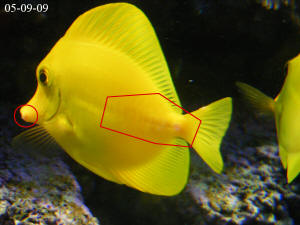 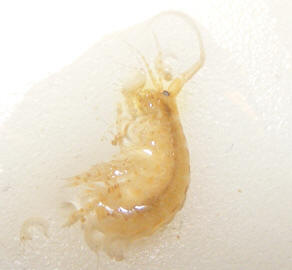 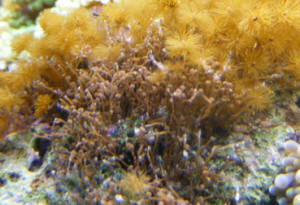 |
Identification Problems - Need
Guidance... Scuds, Myrionema and fish health problems.
5/13/09
Hello WWM Crew!
<Hi Christopher! Mich with you today.>
<<with Christine chiming in>>
I've searched through the WWM website for a while now and I
just can't seem to find a positive identification for three
different things/issues I am having with my aquarium.
<Let's see if I can be of help.>
For starters, my 90 gallon aquarium has been established for a year
and a half. All water parameters are within normal ranges with 0
nitrates/nitrites/phosphates, calcium approx 420, pH 8.2-8.5. I
have 2 percula clowns, 1 Firefish, 1 scooter blenny, 1 yellow tang,
1 powder brown tang, 6 green Chromis, 1 brittle star, 1 Sandsifter
star,
<Not a fan... decimate your sandbed and slowly starve to death.
Best left in the wild in my humble opinion.>
red hermit crabs,
<Not a fan of crabs either... or hermit crabs... Just not to be
trusted.>
common snails, 1 rose bubble-tip anemone (clown host), frogspawn
corals, button polyps, yellow polyps, an beautiful Alveopora,
various mushrooms, a green brain coral, finger leather coral, disk
coral, 2 feather dusters, 2 cleaner shrimp, and a large decorator
crab.
<I'm skeptical with crabs... opportunistic omnivores in my
experience.>
Everything is lit by 150W metal halide lamps and blue actinics. I
have a sump set up below tank with a protein skimmer, filter pads,
and a carbon bag. I do a 10% water change every other week.
<Good husbandry practices will serve you well.>
The first unidentified problem is with my yellow tang (picture
attached). I can't quite tell what the problem is
<Is difficult to see the damage on the tail section in your
photo.>
- but there seems to be some damage developing along both sides
near the 'nails' by the tail. Almost like erosion.
<I will bounce this to Christine, our resident sick fish
expert.>
<<I agree with Michelle--if you can get a better pic or
describe it in detail it might help. Redness (erythema)? Loss of
scales? Symmetrical on both sides of fish? Look like bite
marks?>>
The lip of the tang also seems to be wounded and he is constantly
twitching up against the glass on one side of the tank.
<I do see the abrasion on the lip. This could be caused from the
tang rubbing against the glass, or both wounds may be aggression
from tankmates, perhaps the Powder Brown.> <<Yup, likely.
Sit for a while and watch them--are they obviously at each other,
is one hanging out in a spot that is unusual for it? Could be signs
of sibling rivalry. "Lip locking" is common in tangs. If
not that, could be bacterial, could be a secondary bacterial
infection as well. I'd recommend close observation, with the
potential for moving him out to a hospital tank to treat with
antibiotics. Also, considering the scratching, look closely at how
he moves his gills--are they symmetrical, and more or less rapid
than before? Either could be signs of parasites like Ich, which,
while not causing the redness might be taking advantage of a weak
immune system.>>
When fed, he eats normally (which is a lot!) and his gills look
okay.
<Good signs.>
I thought maybe HLLE but I really have no idea and this doesn't
quite seem to fit the descriptions.
<Doesn't look like HLLE to me from this photo. I would
recommend supplementing your food with Selcon for the
HUFA's.><<HLLE usually runs more anterior, towards the
front or head of the fish, and looks kind of like ulcers. Selcon is
always a good idea, VitaChem, beta-glucan--all good. Even if you
never figure out what the initial issue is, helping him fight it
off by keeping his immune system in good shape via good nutrition
is a big help. Feed often! Good time too to watch for
aggression.>>
No signs of any problems or damage with my powder brown tang or any
of the other fish.
<This would be my first guess as to where the trouble might be
originating.>
The second is a sort of bug that first appeared in my overflow
tank. There are a bunch of tiny swimmers in there also and they
recently have populated the main section of my tank. These
'bugs' (picture attached) get pretty big but they don't
seem to hurt anything - but I like to get things identified in my
tank and do research just so I know. Any help with this one would
be much appreciated.
<Is a good "bug" is a Gammaridean amphipod also called
a Scud. They are harmless detritivores that make good food for your
tank inhabitants.>
The last is a brown growth that has recently started taking over my
tank like an algae (maybe it is an algae).
<Oh! Bad news here. Is not an algae. Is a hydroid, likely a
Myrionema, and you will need to get rid of it. Not fun!
More similar images here:
http://www.wetwebmedia.com/hyzoidf3.htm>
I looked through my algae book and none of the pictures match this
(picture attached).
<Ya won't find it there!>
It is made up of bunches of tiny stemmed 'fuzzies' that now
and again detach and float somewhere else, where it lands and a new
colony starts!
<Get it out ASAP!!!!>
I'm not sure what I can do about this stuff.
<Manual removal with gloves! Most hydroids can sting, not sure
this variety, but better safe than sorry.> <<Could try the
toothbrush-attached-to-siphon hose trick too and scrub those
buggers out. They're nasty.>>
FEEDING: I feed the tank twice daily. The morning feeding is always
the same - Spectrum color-enhancing pellets, which all of the fish
eat.
<Glad to hear.>
The evening feeding is always frozen food and I rotate between
Spirulina brine shrimp, Mysis shrimp, and Emerald Entree.
<Very good.>
I very recently (last week) started supplementing with a Green
Marine Algae with garlic for the tangs.
<Am not familiar with this product.>
As of yesterday, I started supplementing with Marine Snow also, for
the filter feeders.
<Mmm, heard some not so good things about this product.
Cyclop-eeze seems to have a better rep.> <<Coral Frenzy is
also a good one.>>
ADDITIVES: I add liquid calcium to the tank nightly (as per the
instructions) and I also add Strontium/Molybdenum every 4 days and
Iodide every week.
<And you test the levels for all of these additive, correct?
Because add things in unknown quantities is just as dangerous or
more than having a deficiency.>
Thanks for your help crew!
<Welcome!>
Your site is the best and I always find great answers looking
through all of the pages.
<And there is a lot to look through!>
-Christopher
<Cheers,
Mich><<and Christine>> |
|
Orange Spots and Lines on Zebrasoma Tang: No Useful
Information, no reading, ref. 4/26/2009
Hello,
<Hello Jen>
Our Yellow tang has orange "spots and lines" on him
now.
<Hmm... where? May be HLLE, but can't tell based upon this
email.>
Can you please tell me what that is or is from.
<Based upon the information given, no This is the same as
dropping your car off at a repair shop and leaving a note on the
windshield "Car is broken">
And if there is anything we need to do.
<Some more information would be helpful here. How big is the
tank, what is in the tank, what are you feeding him, a picture,
that sort of thing...>
Thank You
Jen
<Mike>
Re: Orange Spots and Lines on Zebrasoma Tang: Severe
Overcrowding\Mixing Incompatible Species 4/29/2009
Hello Mike Again,
<Hi Jennie>
There is <in addition to a Yellow Tang>
1 6 line wrasse, <Moderately aggressive>
2 gobies,
2 Nemos, <Clownfish, aggressive>
3 blue damsels, <Aggressive>
1 trigger, <Extremely aggressive, most grow to over 12"
in length>
1 blue bird wrasse, <Moderate aggressive, grows to over
12">
1 powder brown angel, <Tang - Grows to 8 - 12 inches
long>
1 juvenile, <?>
1 spotted grouper, <Panther Grouper - Grows to over 12"
in length, will eat anything it can fit in its mouth>
some cleaning shrimp.
They get feed Prime Reef Flakes, Marine Pellets, Algae Pad and
Feeder Fish.
<Feeder fish are an exceptionally poor method of feeding see
here:
http://www.wetwebmedia.com/FWSubWebIndex/fdgfdrartneale.htm
>
The tank is a 55gal.
<There is no way that this mix of fish is viable in a 55
gallon tank. This mix would be pushing the limits of a 300 gallon
tank What are the results of your water tests (ammonia, nitrate,
nitrite, etc). Read Here:
http://www.wetwebmedia.com/stocking1.htm and here:
http://www.wetwebmedia.com/mtestrat.htm >
We haven't had no issues with it
<Yes you are, your tang is turning orange - likely as a result
of poor water quality and stress Read here:
http://www.wetwebmedia.com/ytangdisfaqs.htm
>
and we pulled some fish out to put into another tank so we could
add the blue bird and spotted grouper. And now our tang is
turning orange. There are pictures attached.
Thank You Again.
<Please read the above linked articles. Again, there is no way
what you
have in that tank will survive in the long term>
Jennie
<Mike>
|
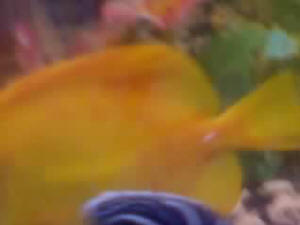 |
|
Yellow Tang, env. dis., reading, not, as usual --
4/17/09
I am new to your website and this hobby. I have a 150g
48Lx24Wx31H Tank. I am using a Sump 30lx12wx19h. Overflow box. NO
SPECIAL LIGHTING YET. Just the cheap lights that it came with so
no Corals yet. I have a protein skimmer (Octopus). 2 Top Fin 300W
heaters. 2 big powerheads and 2 small powerheads for water
flow.
<Okay>
Fish Stock: Yellow Tang, Purple Tang, 1 Black Percula, 2 True
Perculas, 2 Red Firefish, 1 Green Chromis (The Survivor), 2
Sandsifting Starfish, a couple of turbo snails, 1 Sea Urchin, 1
Cleaner Shrimp, 1 Fire Shrimp.
I feed them Frozen Mini Mysis Shrimp, Green Algae, Green Seaweed,
Vitamin Brine Shrimp, Pellets, Flakes with garlic. Not all on the
same day.
That seems about all, water is great. Had ph low but I raised it
to 8.2.
My problem is that my yellow tang seems to keep getting sick. It
had Ich a few weeks ago and it finally went away.
<Mmm, no... tis still about>
Then he had brown spots and the ph was low so I raised it. Brown
spots went almost all away and then he got black spots (not a
lot). Started feeding it seaweed soaked in Zoa« or
garlic. I am also putting VitaChem once in a while. Black spots
went away. I added the 2 Perculas on Saturday and yesterday I
noticed the Y.Tang has now white goose bumps. And some brown
spots have returned.
The picture I have attached was taken on April 7. I have tried to
take a pic of him but he swims away and I can not seem to get
what I see in the pic. It just seems like he's clean. Do you
have any suggestions on what I can do so he can be well.
<Your moves at improving nutrition will help... as will
providing a stable setting here chemistry-wise. I am fairly
confident that what you're observing, doing is a matter of
environmental stress... Not pathogenic...
whatever you treated the system with for the Crypt, the
prevailing conditions... Please read here:
http://wetwebmedia.com/ytangdisf7.htm
and the linked files above. Bob Fenner>
|
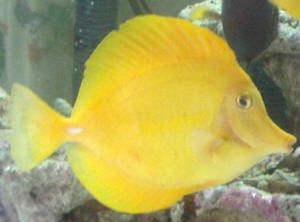 |
Re: Yellow Tang -- 4/18/09
Here are some pictures I took last night. How do I stabilize the
chemistry?
What should I do? I read the link you sent. I check my water and
everything checked ok, just a little bit of nitrates. I am due for
a water change on the 2nd of May. Is there something else I can
feed him or do I just wait.
<Keep reading where you were referred to. BobF> |
Death of Yellow Tang 4/10/09
Moving/transferring Fish
Hi,
<Hello Adam>
I wanted to change from one tank to the other a 2 inch juvenile
Blueface Angel and a 4 inch Yellow Tang as the Blueface was being
bullied by an Emperor Angel introduced into the tank at the same time.
Both fish were very healthy and the Yellow Tang was one of the fattest
I have seen, as these fish seems to suffer malnutrition. I fed him on
fresh tuna and various other fresh marine diet 3 times a day. On this
point I think diet is overlooked in marine fish keeping, personally I
use as much a variety of frozen raw seafood as possible not brine
shrimp etc.
<The main staple of a tang's diet in the wild is marine based
algae.>
One of the tanks had had Ich previously so I decided to do a freshwater
dip for both fish whilst transferring them. The Blueface was in the
freshwater for about 3 minutes less than the Yellow Tang, in total 8 to
9 min.s for the Yellow Tang. The Blueface is fine and eating but the
Yellow Tang died about 3 hours after the transfer. I write as I presume
the death was stress related as I cannot find any information the
Yellow Tangs are very prone to salinity change. Can you please confirm
this is the case as hopefully other can benefit (and their fish) from
this article.
<All marine fish are sensitive to sudden changes in specific
gravity, does not occur on the reefs. When transferring fish to another
tank, water parameters should be very close to the tank they are
leaving. And yes, this will cause unneeded stress on the
animal.>
<<Mmm, Zebrasoma flavescens regularly swims into very fresh water
near the sea shore in Hawai'i' (where it hails from.).
RMF>>
Regards,
<Cheers. James (Salty Dog)>
Adam
Yellow Tang/Health 4/1/09
Hi crew,
<Hi Marc>
I purchased a Yellow Tang today, it <I> added it to my 75 gallon
reef tank.
I was reading on your site about them last night, when I got home,
prior to putting him in the tank, I noticed a very faint red coloration
on his fin. I wouldn't have even seen it, if I wasn't looking
for it. It looks like Septicemia.
<It's no surprise to me as these fish can only be kept in water
taken from Cozumel's Paradise Reef (April Fool).
Septicemia is the presence of bacteria in the blood, and I've never
heard of this disease present in fish. Bob may input
here.><<Have witnessed this on MANY occasions... in fresh,
brackish and marine fishes. RMF>>
I have been reading the FAQS, and I am confident this is the result of
handling, and being in too small of a tank at the pet store, plus it
was kept with much more aggressive tank mates. My question is, do you
think it
should go away, now being in a bigger tank, and very possibly better
water quality?
<Likely stress/environment related. With good water quality and
diet, the tang should recover.>
Or is this something I should really treat it for? It's swimming
all over the tank and eating non stop off the sides of the tank, live
rock and powerheads. And like I already stated, it looks like a very
mild case.
<I would not treat but concentrate on water quality/diet and
continue to observe.>
Thanks for your help,
<You're welcome. James (Salty Dog)>
Marc
Sickly Yellow Tang 3/14/09
Hi. I browse your site often, and usually find what I am looking for,
but I have a problem with my yellow tang that I have been unable to
resolve through research. I have had my tank set up for about a year
and a half now, and moved it last November (saving every drop of water
in the tank) with no problems in the move. The tank is 55 gallons, with
at least 25-30lbs live rock, a Marineland C-360 canister filter, a
protein skimmer, and I keep it at around 78 degrees. The pH is 8.2, but
it has been around 7.8 for a month because my first protein skimmer
broke and there was not enough oxygen in the tank.
<Yikes>
My calcium is in the range of 450-500mg,
<Mmm, high>
and the alkalinity is slightly high. The specific gravity is usually in
the range of 1.25-1.23,
<Missing a decimal place... but I get what you likely mean>
and there is 0 nitrites, nitrates, and ammonia. The phosphates are
slightly higher than zero, but probably worse because I have rampant
hair algae growth since the move, which I am working on remedying by
using Algaefix
<I would NOT use this... too likely to cause toxicity
problems>
and pulling the algae out manually. In the tank are 6-8 hermit crabs, 1
turbo snail (I haven't had much luck with them), a mushroom polyp,
some very happy Zoanthids, a branching coral fragment, a blue Chromis,
two pink skunk clowns, recently two Firefish, and the yellow tang, who
is about 2.5-3" currently. (I plan on purchasing a larger tank in
the near future for him) I feed them frozen Spirulina brine shrimp once
a week, flake food daily (they won't eat pellets) and the Tang has
Julian Sprung's Seaweed sheets. The problem I am having is that the
tang's color is not good. He remains in the stress coloration- very
whitish, and he sometimes is reddish. His appetite varies from ravenous
to just picking at food, but he has never refused to eat.. He hides,
but is still curious about what is going on with his surroundings. I do
small twice monthly water changes, and he perks up after them.
<A good clue here>
Also, his dorsal fin has not been right for months. It is jaggedy on
the edges,
<Good observation>
but there are no different colors at the edges to indicate infection. I
have tried treating him with Melafix and Pimafix, but nothing seems to
help. I worry that one of the fish might be biting him, but I have not
observed it. If you have any suggestions on how to make him happy and
colorful again I would really appreciate it. Thanks!
Chardelle Cochran
<Mmm... well, the use of the Algicide is trouble... and there may
well be some trouble with Cnidarian allelopathy here... Please see WWM
re... Here:
http://wetwebmedia.com/maralgcidefaqs.htm
and here: http://wetwebmedia.com/cnidcompppt.htm
and the linked files above. Bob Fenner>
|
Yellow tang - urgent help... Not
urgent as in rapid onset... iatrogenic... 02/09/09 Hi
crew, I need help, please. I have noticed that 4 of 15 yellow
tangs have some redness within a FOWLR. <15?! I'm afraid
to even ask... how big is this tank??> If have checked nitrate
< .2ppm, nitrite 0, phosphate .05 ppm, KH 10, calcium a bit
high at 550ppm, magnesium 1250ppm still need to get a new test
kit for ammonia. I am unsure if it is a dieses, injury, etc, I
have attached some pic to help. <These fish are clearly not in
good shape. Please do measure your ammonia. Are they eating?>
Can you please let me know what would cause this? <15 tangs in
one tank!? I suspect, unless you have a 1000g tank... you have a
serious overcrowding issue!> thanks
Mohamed
<Best,
Sara M.>
|
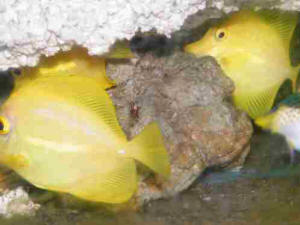 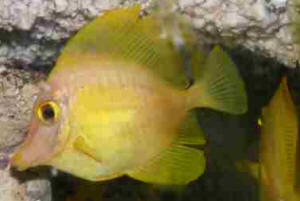 |
|
Re: yellow tang - urgent help 02/10/09 Hi
Sara, they are in a temporary holding tank with +-200g with 2
medium 6cm and the rest are between 3cm -4cm in size. Yes they
are all eating, Nori, a variety of frozen food, pellets, live
food, etc. A LFS checked the ammonia which is 0. <Redness on
tangs is sometimes evidence of the fish just being over stressed.
Have you tried looking through these articles?
http://www.wetwebmedia.com/toxictk.htm
http://www.wetwebmedia.com/tanktroubleshting.htm > Thanks
Mohamed <Best, Sara M.>
Re: yellow tang - urgent help 02/11/09 Hi
Sara, Thanks for the link to the articles, interesting read. I
have come to the conclusion that all parameters are okay so the
only logical explanation will be stress. I did a 60% water change
yesterday to be safe but I am going to move some of the tangs to
another tank by the weekend. <This is a good idea.> Thanks
Mohamed <De nada and good luck, Sara M.>
Re: yellow tang - urgent help 03/04/09 Hi
Sara, an update on the yellow tangs. I have moved some of the
tangs to another tank and the redness is gone. <Ah, good.>
Another question, I have noticed that 1 yellow tang is bloated
but still eats fine. Firstly is this dangerous, secondly is there
a known cause and remedy? <Could be... it might be
constipated... please see here:
http://www.wetwebmedia.com/tanktroubleshting.htm> Thanks
Mohamed <Cheers, Sara M.>
|
Yellow Tangs and QTs Q&A 1/29/09 Hey crew!
Thanks so much for always being the to save the butts of us struggling
hobbyists ;-) <Happy to help> Have been patiently awaiting the
time when I could afford to add more fish to my 75g display tank :-)
(I've had one 3" GSP in there by himself for 6 months now!)
Lucky little fellow... (Is he ever going to grow bigger? That's the
size I got him 9mos ago in FRESHWATER at Wal-Mart (bless his heart!))
<Mmm, may have an internal parasite issue... or maybe you're
just underfeeding?> Anyway, the display tank is wonderful. A healthy
amount of Coralline Algae is starting to appear (pinks, purples, and
reds on rocks...and greens on glass. Any explanation? I read it had to
do with lighting...no big deal - just curious.) <More to do with
physical, lighting, chemical conditions, a dearth of predators and
competitors... Read here: http://wetwebmedia.com/corlinesysfaqs.htm and
the linked files above> Anyhow, I decided to get a yellow tang,
under the advice on the puffer forum that he would be an okay fit in
the tank, and due to the fact that some of the live rock I initially
placed in the tank seeded small amounts of red bubble algae, green hair
algae, and another unidentified similar looking form of nuisance algae
which I've been keeping at bay with manual removal, but thought the
help would be nice. :-) Enter Yellow Tang. Purchased at not-so-great
LFS (attached to an Ace Hardware). They were wonderful until the girl
who ACTUALLY knew what she was doing moved. Now they don't know
much over there. <Good point re the value of individual staff...>
They didn't even know what a yellow tang was!!!... one of the guys
called it "the Nemo fish" (In reference to bubbles, I'm
sure). At any rate, looked relatively healthy - but most of their fish
did not. I didn't ask questions (my mistake!) when I purchased
him...just brought him home. Acclimated to same salinity, cycled, 10g
QT for about 30 minutes, and then released from bag. I'd also
placed some of the more heavily algae filled rocks (just 3) into the
QT, giving him something to munch. He hid all day the first
day...second day placed a half a cube worth of brine shrimp to
supplement his eating. Also brought home some Nori :-). He had started
to come out and was swimming fine, later that evening (he had been fine
30 minutes before) we went to check on him, and he was lay ing on his
side on the bottom of the tank with labored breathing. At the time, I
knew I had done everything I could, and knew how to. But I knew he was
probably going to be a goner. The LFS said they'll give us another
one (tomorrow!) when it gets shipped in. <Best to leave such new
arrivals to rest for at least a few days...> Generally, because of
the horrible conditions of the LFSs around here, I preventative treat
all my fish while in QT. I was using a combination of premeasured
"Super Ick Cure" by API and "Triple Sulfa" by API.
I have since read some nasty things about Malachite Green (even though
said it was safe for saltwater...) Wondering if this could have been
the cause of death? <Might "push" animals over the edge if
they are too far gone...> The mix contains 3.6 mg of Malachite Green
and 60mg of Nitrofurazone. Triple Sulfa contains 664 mg Sodium
Sulfathiazole, 168 mg Sodium Sulfamethazine and 168 mg Sodium
Sulfacetamide. Would it be smart to only use half recommended dose on
next fish? Should I use any? <I would not use this/these product/s
unless there was clear indication of need... evidence of protozoan
infestation> Also, in re: my QT tank. My plan for today (since I
don't have time to completely cycle new saltwater) is to remove 10g
from my DT (PH 8.2, SG 1.019, NitA: 40ppm, NitI: 0, Amm: 0), and place
it in my QT, while adding 10 gallons of new salt water to my DT
(raising the SG just a bit - less than .002). Does this seem like a
good plan? <I would be checking the spg of the shipping water
to/through the store and the store itself... and reading on WWM re
hyposalinity... See the search tool/link on every page> Lastly, the
few pieces of rock I had in the previous QT. Should I just scrub them
down and start over with them? Can I just rinse them in some new
saltwater? What would be your suggestion? <Reading> Sorry for the
dissertation. thanks for everything. Hopefully I'll get to speak to
the manager of the fish dept tomorrow, and he can answer some q's
for me and get the fish to eat in front of me, etc. Is there anyway to
make the QT less stressful for him? <... see WWM re> Jessica
Bishop PS I just got the coolest job in the world! My husband is a CSM
for Wal-Mart, and people return live (albeit sick) fish all of the
time. Wal-Mart's policy is they have to dispose of the returned
fish. SOOOOO my hubby brings them home and I get to try to save them!
YAY! (usually goldfish, maybe one of these days I'll get some GSPs
:-)) <Ahh! Good for you. Bob Fenner>
|
Dark Splotches on Tang 1/28/09 Hi there and
thanks in advance for reviewing my correspondence. I, like so
many others, appreciate your expertise and for sharing it in this
type of forum. <A pleasure, honor and duty to share> I have
live rock only 55 gallon salt water set-up with a 1.5 inch
pacific blue tang, a 1.5 inch Huma Huma trigger, 1 false percula
and a 3.5 inch yellow tang <Yikes... this is too crowded and
incompatible a mix...> which is my fish with the problem.
Ammonia -- 0, Nitrites -- 0, pH 8.4, Nitrates -- 10, spg 1.024. I
will start by advising that I will be trying to finding him a
larger home if I am able to get him healthy again. <Needs this
TO be healthy> I am aware this tank size is too small for him
but he came to us with nowhere else to go and I couldn't turn
him away. He came out of quarantine about 2 weeks ago where he
was being treated for septicemia with Furan II. He refused to eat
the entire stay (2 weeks) in quarantine but when he appeared
healthy again (as best I could assess visibly) he was returned to
the display tank. I did notice where he had been red with the
septicemia, the places turned to a darker red, to brown and then
to black. I assumed that was blood and the small black spots have
since been clearing up. Although it may be something else
entirely. I have seen black Ich and it doesn't look like that
when you can see him up close. While in quarantine he did loose
some of his bright yellow coloring but with lack of nutrition,
stress and meds I assumed this to be somewhat normal for his
circumstances. I returned him to his home in the evening and he
immediately began eating vitamin soaked Mysis shrimp again the
next morning as though he had never been away. <Good>
However, I still have not witnessed him eating his seaweed or
Nori, which he aggressively ate in the past. His respiration is
increased, he is eating but not very much as compared to just a
week ago, doesn't swim around as much as in the past and even
seems to slightly lean to one side or the other intermittently.
This morning I woke up to find 2 black-ish colored splotches on
him that appear to be under the skin. One splotch is on his nose
and the other is more toward his tail. I am wondering what is now
plaguing my already stressed out fish. I am concerned that any
further quarantine could do more harm than good for him at this
point and I wouldn't quarantine without feeling confident
about a clear diagnosis and treatment. His tank mates appear
unaffected. I have attached a couple of pictures (the one that is
most clear is the spot on the nose )in hopes that you may be able
to make an identification and tell what, if anything, I can do
for him. Thanks for your time and help Monica <The
decolorizing manifests itself from general "stress"...
in this case the crowding mostly... With movement to larger, more
suitable quarters, space to get away from the Paracanthurus and
trigger... it can/should heal. Bob Fenner>
|
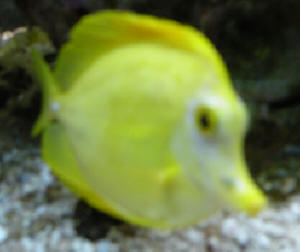 |
|
Yellow Tang eye problem - Question 12/28/08
Dear Wet Web Media, <Mark> I haven't posted here
before, but I use your site a lot for advice and suggestions. You
have produced an excellent resource here, so keep up the good
work. <Trying> Now, naturally, I would like to ask you some
advice if you have time: <Sure> I have a yellow tang that
has developed a cloudy lens in one eye, with what appears to be a
small white raised "mountain" in the centre of the
lens. <I see this in your pix> I do not detect that the
white "tick" on the eye is a living parasite, but it
could be. <Mmm, no, not here> And that is my question
really: Is this likely to be a parasite I should be treating, or
is this likely to be just an injury that requires no treatment?
<The latter> He (or she) appears to have gone off food a
bit. He is usually picking on the rocks all the time, but now he
appears listless and does not pick on the rocks. Although he did
just come for some flake food. The yellow tang first developed
this condition a few days ago, and then he appeared fine for a
few days. Yesterday I had to rearrange the tank to extract a
failed powerhead from behind the reef and add 5 Anthias and some
corals I had quarantined (for 5 weeks), and today his eye
condition has returned, worse if anything. Could this be related
to the stress of rearranging the tank he lives in? <Yes... and
the other livestock addition, though it likely originated with a
physical trauma> Could he have bumped something in the
unfamiliar environment? In the exophthalmia and pop-eye FAQs on
WWM, I see that much of the time similar problems appear to be an
injury, <Yes> but the fact that this problem has reappeared
again, makes me wonder if this could be something other than an
injury? <Could be a recurrence> Or is he just silly enough
to keep bumping the same eye? <Unfortunately, yes> More
details: The yellow tang shares an approx 625 litre (165 US
gallon) tank with: 5 Lyretail Anthias 2 common clowns 2 cardinals
2 yellow neon gobies 1 orchid Dottyback 1 psychedelic mandarin 1
cleaner wrasse <Not easily kept> 1 yellow watchman goby 1
yellow pistol shrimp (paired with the goby) 1 fire/blood shrimp 5
blue leg hermit crabs about 15 snails various soft and hard
corals about 80KG of live rock and about 35KG of live sand. Water
parameters are: Ph 8.0 Ammonia 0 NO2 0.01 (if you look hard and
you want to see some color) NO3 2 PO4 0 KH/Alk 8.48/3.03 Mg 1200
Ca 390 O2 8 Tank has a sump which incorporates: Mechanical
filtration Deep sand bed Refugium Skimmer Fluidised Rowaphos in a
reactor Fluidised aragonite sand in another reactor The usual
heaters and a chiller Tank is lit by 3 400w metal halides and 2
80w T5 actinic tubes. Tank has been running for 9 months. I
attach the best two pictures I could get. I cropped them. I hope
they are not too big. Thank you, Mark <Sounds/reads as a very
nice system. I do think this Zebrasoma "ran into
something"... and will likely cure in time of its own
accord. Bob Fenner>
|
 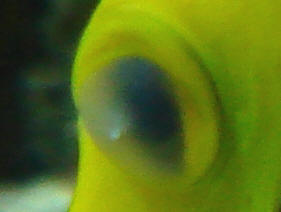 |
|
Re: Yellow Tang eye problem -
Question 1/5/09 > I do think this Zebrasoma "ran
into something"... > and will likely cure in time of its
own accord. Bob Fenner Thanks Bob. It seems you were right. He
must have run into something. We now call him Bang Tang.
<Heeee!> I took your advice and did not treat the problem.
I thought I would send a follow up note for the benefit of others
who might experience this problem in the future, to say that a
week later the tang's eye seems to have returned to normal of
its own accord, as you predicted. Thank you for your advice, Mark
<Thank you for this follow-up... Know that you have saved many
folks consternation, and preserved the health of their livestock.
Bob Fenner>
Surgeonfishes: Tangs for Marine Aquariums
Diversity, Selection & Care
New eBook on Amazon: Available here
New Print Book on Create Space: Available
here
by Robert (Bob) Fenner |
 |
|
|
|

